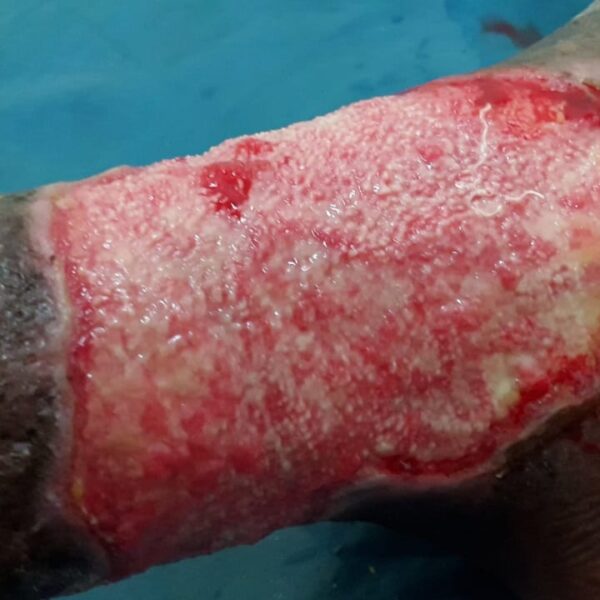Leg Ulcers in Sickle Cell Disease
LEG ULCERS IN SICKLE CELL DISEASE.
Leg ulcers are one of the complications that affects people living with sickle cell disease. A leg ulcer is a break in the skin of the leg which causes sores and open wounds on the leg. Leg ulcers in sickle cell normally occurs in the lower extremities of the leg precisely the ankle area where there is not enough fat and low blood flow and are said to be common in sickle cell (SS) and often happen in male warriors than female warriors.

CAUSES OF ULCERS IN SICKLE CELL DISEASE.
Causes of leg ulcers in sickle cell is not exactly known but a lot of studies show that it is caused by poor circulation due to the shape of the red blood being rigid, they cause narrowing of small blood resulting in pain preventing blood flow and oxygen to the parts causing ulceration.
SYMPTOMS OF LEG ULCER IN SICKLE CELL DISEASE.
Symptoms of leg ulcers include Pain, discoloration and darkening of the affected area, itchiness, Inflammation in the leg, open wound, yellowish or brown pus in the affected area and heaviness in the leg and fevers if infected.
DIAGNOSIS AND TREATMENT OF LEG ULCERS.
It’s important for sickle cell patients to observe symptoms of leg ulcers and seek medical attention immediately they notice them. An examination by the doctor and tests such as blood tests, CT scan, ultrasound and x-ray can be done to determine the treatment plan.
Early treatment is very important as it helps to relieve pain, manage the wound, and prevent infections of the wound and further damage. The treatment management can include the following:
- Pain management to help with the pain. Leg ulcers in sickle cell can be extremely painful and can cause nerve and neuropathic pain. It’s important to get the right pain medications to relieve the pain.
- Antibiotics to treat infection.
- Zinc supplements to help with healing
- Compression bandage and stockings to help maintain pressure in the veins, prevent swelling, covers the wound to prevent infections and return of ulcers once healed.
- Blood transfusion and Hydroxyurea. Blood transfusion and hydroxyurea has shown to reduce ulcer development in sickle cell as well as prevent further damage.
- Surgery once the leg ulcers heal is recommended to help restore some of the damaged skin with the help of skin grafts.
MANAGEMENT OF LEG ULCERS IN SICKLE CELL.
It’s important to keep the wound clean and dry to prevent infections and reoccurring. Washing the wound with mild clean water and soap, changing any bandages, and dressing at least once daily, this will keep the wound dry promoting healing. Elevating the leg, wearing good fitting shoes, not standing for a long period of time, and having a balanced diet full of vitamins and minerals will help in the healing of leg ulcers. Leg ulcers in sickle cell disease heal very slowly and can be very painful and severe. They can affect a warrior’s day to day activities and self-image. Therefore, it’s extremely important to seek medical attention for treatment as soon as possible to avoid debilitating complications.
Please note these tips are not a replacement to any medical advice given to you be your healthcare professionals. See your Haematologist for all sickle cell management.
References:
- Akinyanju O, Akinsete I. Leg ulceration in sickle cell disease in Nigeria. Tropical and geographical medicine. 1979;31:87–91. [PubMed] [Google Scholar]
- Koshy M, Entsuah R, Koranda A, Kraus AP, Johnson R, Bellvue R, Flournoy-Gill Z, Levy P. Leg ulcers in patients with sickle cell disease. Blood. 1989;74:1403–1408. [PubMed] [Google Scholar]
- Mack AK, Kato GJ. Sickle cell disease and nitric oxide: a paradigm shift? The international journal of biochemistry & cell biology. 2006;38:1237–1243. [PMC free article] [PubMed] [Google Scholar]
- Mohan JS, Marshall JM, Reid HL, Thomas PW, Serjeant GR. Postural vasoconstriction and leg ulceration in homozygous sickle cell disease. Clin Sci (Lond) 1997;92:153–158. [PubMed] [Google Scholar]
- Trent JT, Kirsner RS. Leg ulcers in sickle cell disease. Advances in skin & wound care. 2004;17:410–416. [PubMed] [Google Scholar]
- Serjeant GR, Serjeant BE, Mohan JS, Clare A. Leg ulceration in sickle cell disease: medieval medicine in a modern world. Hematology/oncology clinics of North America. 2005;19:943–956. viii–ix. [PubMed] [Google Scholar]
